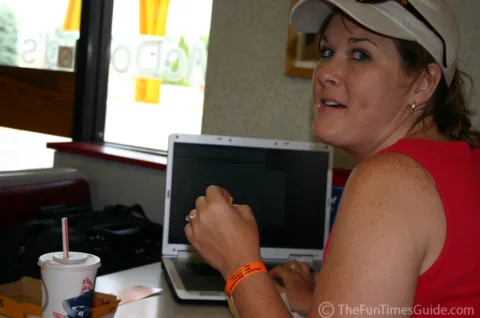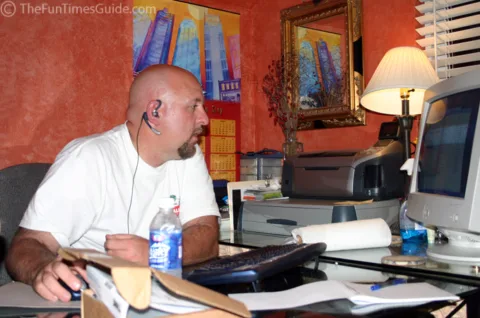On my way in to work yesterday morning, I jotted down the following list I titled “Things We’ve Learned About Doing Websites”. (Like usual, it was bumper-to-bumper traffic. And you know me… I’ve always got a pen and a pad of paper on hand! So I put the time to good use.)
I was thinking that new bloggers and website owners might find some value in hearing from someone who’s been there, tried that.
We have definitely learned a lot in the 8 years 17 years that we’ve been blogging.
Without a doubt, the most valuable tidbits have been learned by experimenting & trying new things with this very blog that you’re reading: The Fun Times Guide to Gadgets & Tech. But it’s not the only one.
Here are a few of our other sites:
- The Fun Times Guide to Dogs
- About 4Wheeldrive & Offroading
- The Nashville Fun Times Guide
- The Fun Times Guide to Log Homes
- Hoosier Thunder Motorsports
- The Fun Times Guide to Household Tips
Without further ado…
14.5 Things We’ve Learned About Doing Websites
#1 – People do not “read” — even when it’s something they’re interested in.
Based on the large quantity of e-mails we receive (usually from people with AOL email addresses, by the way) many people “skim” rather than actually “read” the content on websites.
That, or they check briefly what the article is about… quickly think of something related to that article they’d like to know about… and zip out an email to us asking for information about so and so.
It’s quite comical, because if they’d only read the article (which, I admit, many of my articles are too long and are not easy to read “quickly”), they would have found the answer to their question!
On a related note, I’m also surprised how many people don’t use CTL+F to find something on a page.
Here’s how to write skimmable content.
#2 – Pictures (yes, even poor quality ones) make a good article great.
Not only do pictures add visual interest to an article (by breaking up all the copy), pictures also lend credibility to what it is you’re writing about.
The good part: Pictures also increase the amount of time readers stay at your site, and how much they click around to see other things on your website.
Here are 6 powerful reasons to include images in your posts.
#3 – Don’t be afraid to try new things.
When it comes to websites, I’m more conservative than Jim. When we find something that works, I like to stay within my comfort zone and just keep doing what we’re doing. Jim, on the other hand, prefers to push the envelope. “Yeah, it’s working great, but if we did this, it could work even better!”
I (reluctantly) would have to agree. If you always do what you’ve always done, you’ll always get what you’ve always gotten.
It is only by taking chances that we’ve discovered new (read: more fun, more interesting) ways to do things and boost our readership at the same time.
A good read: Creative Risks – The Fine Art Of Risk Taking
#4 – The more “evergreen” (not date-specific) your content is, the better.
Evergreen content has greater staying power on the Web. Since it’s not time-sensitive material, it continues to find its way in front of new readers every single day.
That means one evergreen article will be read for years to come!
That’s huge when it comes to a site’s popularity and ranking in search engines — over time.
Here are 4 tips for creating evergreen content.
#5 – Content is king. Period.
 Wait, I mean quality content is king.
Wait, I mean quality content is king.
Specifically:
- Honesty is the best policy. If you’re writing about something you’ve experienced firsthand, then it’s likely to be quite valuable to others who may be in your same boat somewhere down the line. (Keep in mind, there’s a big difference between writing something negative for the purpose of bashing someone or something, and writing something negative with the intention of informing others and offering constructive criticism.)
- Fewer opinions, more facts and firsthand experiences. The more you can validate what you’ve written — with supporting research, stats, or others’ experiences — the better. Even your own opinions appear more credible when similar opinions have also been expressed elsewhere.
- Short and to-the-point. (As you can tell, I struggle with this one.) If you can say the same thing in fewer words… do it! Why? Because, most people don’t want to plug through lengthy articles — despite how “interesting” they may be — to find the point (or many points!) within your article. Most visitors are not interested in reading novellas online. Many of our shorter articles are far more popular than our lengthier (better) articles.
Here are more examples illustrating why quality content is king.
#6 – Allow comments.
Way back when, when we first started this blog, we turned the comments off because most of what we received was just comment spam at that time. I’d guess that’s what it’s like for most sites when they’re just starting out.
It’s not until people start seeing others commenting that they realize it’s a respected site with content that’s worth commenting about. Plus, comments are infectious… people love to see their name and their $.02 in print.
Here’s a good read: Do More Comments Make Your Blog Stronger?
#7 – You don’t have to post every day.
While you’ll definitely get more traffic if you post a new article daily, it’s certainly not a requirement for having a successful blog. It might be a requirement for having a mega-blog, or one that goes viral, but not if you just want to make a good living from your blog.
Sure… the more frequently you post, the more people will see your stuff. But we’ve managed to survive (and thrive!) while only posting once a month at times. Seriously. It’s OK.
The biggest difference between us and other bloggers who post daily (or more) is the number of repeat visitors. Since we don’t post regularly, we don’t have a lot of repeat visitors who come back just to read every article we post.
Our traffic is mostly organic — which means that people search for something on Google and they find us. I’m here to tell you that you can have a successful blog from organic traffic alone.
Here’s a great blogging tip: You Don’t Have To Be #1!
#8 – Give your readers a reason to want to stick around.
Make it easy for your readers to find other articles on your site that are similar to the one they just read.
The easier you make it to navigate around your site, the better. That means: Spell out as much as you can for your readers. Put things right before their eyes. Don’t expect that they’ll find something relevant or related on their own.
For instance, here’s one thing we’ve learned: Dropdown lists (for categories, for example) don’t work nearly as well as simply displaying a list (categories down one column of your page, for example). Unfortunately, if you’re limited on space, then you have to ask yourself which is more important — readers seeing the category names, or readers seeing the titles of recent posts (or something else more timely than a list of categories).
#9 – Link to as many relevant (and credible) sources as possible — even if some of those sources are from your own website(s).
To give your articles credibility and higher page rank in search engines, it’s important to include hyperlinks throughout your article. But not just any links.
You should only include links that are highly relevant to the specific topic you are writing about, and they should only be links from highly reputable websites.
And yes, linking to your own content is just as important as linking to other sites — and having them link back to you.
So, if you have several websites on various topics, I would encourage you to link relevant content together. This helps to build traffic and credibility. Try it. You’ll be amazed how many people stick around on your site longer and how many repeat visitors you’ll acquire!
#10 – Reply to your readers’ questions right away.
No matter how mundane some of the questions (or personal requests) might be from the readers of your site, if you take the time to reply back to each one of them in a timely manner, you’ll build loyalty.
However!… Don’t expect a “Thank You” in return, because you rarely get one. (I know, I was surprised by this too.)
Here’s proof that responding to comments keeps readers on your site longer.
#11 – Old-fashioned hyperlinks (underlined) work best.
While different colored links, flashing links, cool designs around links and such are hip & cool and may look nice to you, there are a fair amount of people who just won’t notice your links if you do those things.
People (especially novice computer users) are looking for traditional underlined links. And they’re not likely to click on anything but.
So if you’re going to the trouble to find and place relevant links throughout your articles, make sure your links are of the old-school style: underlined!
Must read: Reasons To Make Your Hyperlinks Underlined
#12 – A surprisingly large number of visitors actually click on the ads!
It’s true — as long as the ads are relevant to the content within that particular article.
For the record, I click on ads at other websites, too. If it’s a product that I’m genuinely interested in, then I don’t hesitate to click on an ad. I’ve found that the majority of ads are from reputable companies, and we’ve actually purchased a great deal of items through online ads.
Wondering how much money bloggers make? Here’s a list of extremely popular bloggers’ salaries.
#13 – The more “bloggy” your content is… the better.
 I think this goes hand-in-hand with numbers 1 and 5 above. People are on the Internet looking for quick answers to their pressing questions.
I think this goes hand-in-hand with numbers 1 and 5 above. People are on the Internet looking for quick answers to their pressing questions.
At the same time, they tend to place a higher value on articles which describe people who’ve been in the same situation as them — people who have similar (or different) opinions as them, and people who are interested in hearing what others think about a given topic.
That’s why blogging has taken off so well and it continues to be a reputable source of information. The Internet is filled with short and to-the-point content about anything and everything — firsthand accounts about everything under the sun!
Things that make a site look “bloggy”:
- a date
- an author’s name
- a casual & fun writing style
- supporting photographs (they don’t have to be professional quality)
- a different headline in the lead position on your website every so often
For the record, our websites are more content-rich and niche (based on one specific topic) than traditional blogs are. While many people use their blogs as a place to vent and rant their opinions in general, we try to stay on topic and and provide readers with useful “takeaways.” Maybe that has something to do with why we’ve managed to stick around longer than most ‘traditional’ bloggers have.
Here are the pros & cons of niche blogging.
#14 – And (drumroll, please)… Social networking isn’t all that it’s cracked up to be!
I’m not saying that it doesn’t have its good points, I’m just saying I wouldn’t spend a lot of time spinning your wheels trying to “do what everyone else is doing”.
We don’t. Yet, surprise… our site is doing quite well. In fact, several of our sites are doing quite well.
Granted, social networking sites make it easy to promote your own websites and content, and they’re a great way to get your website noticed by people who never would have found your site on their own. But when it comes right down to it — in my mind anyway — a quality site really should be able to stand on its own as a credible and reliable source of information. I’m proud of the fact that many of our websites have acquired audiences in the tens of thousands each day, primarily by virtue of having good quality content alone.
Everyone thinks social networking will magically make their content go viral. Trust me, it rarely happens that easily. Social networking is still a good thing to include in your repertoire, but it won’t make you an overnight success. And posting something on your own blog — where you own it and it resides for life — is way better than posting that same thing on a social network — where you don’t own what you share there and the site could go away tomorrow.
On the other hand… linking to your so-called “competitors” and talking-up anyone who has a site like yours is worth its weight in gold! Most people are so afraid of linking to people who have content that’s better than theirs that they avoid it. But on the Internet, there is no competition. Instead we all learn from each other. And we all share each others’ stuff — if we think it would be helpful to someone else.
Here are 5 reasons why blogging is better for your business than social networking.
#14.5 – You don’t always have to do things “by the book”.
Case in point: Include 14.5 things in a list, rather than ending with a number that makes sense to most people — like 15.
There are no rules here.
Don’t paint yourself into a box — be yourself. And go with your gut. That’s what makes you different from all the others out there doing what you’re doing.
Remember, there’s nothing different about your blog except for one thing: you!
What Goes Around, Comes Around
Overall, we’ve been fortunate to enjoy huge amounts of success with our FUN little websites. Now we have 32 of them!
Who knows, maybe we could’ve gotten to where we are a bit quicker had we incorporated some of the practices that bloggers typically use to boost their traffic — like huge amounts of social networking… massive commenting to others’ sites… and boatloads of spammy link exchanges. But it wouldn’t have been nearly as fulfilling as plotting our own course on the World Wide Web.
Everyone gets where they want to be by their own means and methods — we all learn at our own pace, and no one does it perfectly the first time.
I encourage you to start plotting your course for adventure as a blogger… today. And have fun.
Our Personal Rewards
- We’ve managed to stick around a lot longer than most “traditional” bloggers. (We attribute that mostly to our content.)
- We still enjoy writing copy, taking pictures, and sharing ideas on each of our blogs day in and day out. (That’s because we are truly passionate about what we do.)
- And, the future definitely looks bright for this blog in particular, and all of our other websites in general. (We’re going to keep doing whatever it is that we do — because it works!)
To our many readers: THANK YOU!
How To Start A Blog
In my opinion, these are the best resources to help you start your own blog:
- How To Start A Blog: The Basics
- Blogging 101: Everything You Need To Get Started (7 Chapters)
- 40 Things I Wish I Knew Before I Started By Blog
- The Best Checklist For New Website Owners
- Don’t Make These Blogging Mistakes
- How To Make A Free Website: 10 Free Website Building Platforms
- 11 Steps To Get Your Site Indexed On Google
- How To Start A Successful Blog… Today!
- WordPress vs Squarespace: Which Is Better?
- 12 Must-Do Tasks For The New WordPress Site Owner
- Pros & Cons Of Free vs Paid Blogging Platforms
- How To Set Up Your SEO-Friendly WordPress Website In 15 Minutes
- Blogging FAQ: How To Make Money Blogging
- Want To Make Money Blogging? 10 Things You Need To Know
UPDATE:
This article happens to go hand-in-hand with something Seth Godin wrote the other day (The 8 Free Things Every Site Should Have). Oddly enough, I wrote this before I read Seth’s post. Both Jim and I are long-time admirers of Seth and have been reading his Blog for some time. (I think it’s the bald head thing — hee hee.) But I was a few days behind on reading Seth’s Blog, so I found it interesting that I had written something very similar… yet different.







